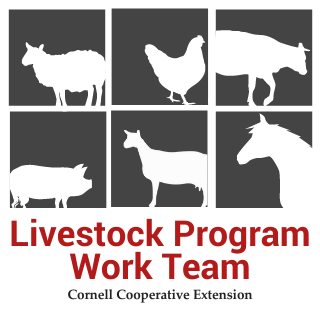Grazing Small Ruminants to Avoid High Spring Parasite Loads
By Amy Barkley, Livestock & Beginning Farm Specialist, Cornell Cooperative Extension SWNY Team
Getting our sheep and goats out on pasture is something that we all look forward to this time of year. Having the animals outside makes it easier to get the barns cleaned and helps decrease our feed bills. Plus, there’s nothing more serene than watching our charges walking in the lush green grass, heads down, thoroughly enjoying the buffet after a winter of stored forage.
At the same time, internal parasites that have been hibernating in the gut lining during the winter, including the infamous barber pole worm, the main cause of anemia in our sheep and goats, are starting to “wake up” and cause higher rates of clinical disease. They’re also now reproducing, which means that we must be vigilant as we begin our pasture rotations, even this early in the season.
The barnyard or sacrifice lot is going to the most highly infected pasture this time of year. This is especially true if the animals have had access to it for months on end because eggs and infective larvae populations are building up. Unless your sacrifice lot has an impermeable surface, there’s going to be forage growing either inside or around the perimeter. Our small ruminants think that these small shreds of green are delightful. This presents two issues. First, sheep feces, and subsequently worm eggs and larvae, are polluting this area. Second, these little bits of grass are so scarce that they will be eaten down to the ground. As many of us know, the closer a sheep or goat eats to the ground, the easier it is for them to pick up infective larvae. Therefore, it makes sense to move the animals from this area as soon as the pasture has enough forage (6” at a minimum) and is dry enough to accept them. It’s also a good idea to disallow them access to their winter barnyard for 60 – 90 days to allow the high numbers of larvae to die off. If they need to access a barn through a sacrifice area, eliminating any green forage will help, as will fencing off a walking path to discourage them from consuming anything on their way to and from their pastures.
In terms of general pasture management, move the animals to a pasture that has not been used in the past 60-90 days or will not be used for lambing/kidding unless there will be a 60-90 day rest period between when you put them out and when you expect lambing/kidding season to start. Lactating animals and nursing young are some of the most susceptible to parasitism because of their weakened immune systems.
Before letting the sheep or goats out to graze for the year, it may be tempting to deworm everyone to give them a clean slate. Research into parasite resistance indicates that this is not ideal. If a whole population of worms is treated only those resistant ones will survive and reproduce, leading to a resistant population. Instead, individuals should be checked for parasite loads through a Five Point Check© to identify animals appearing to have a substantial gastrointestinal parasitic worm load by screening animals for unthriftiness, diarrhea, and anemia. The Five Point Check© should always include FAMACHA© scoring the animals to estimate their state of anemia because anemia is the primary indicator of barber pole worm infection. For herds and flocks with under 50 animals, all should be checked. If over that number, 50 individuals representing the herd can provide a good measure. Those animals showing danger signs based on their Five Point Check© should be dewormed, with future herd checks scheduled every 2 weeks throughout the grazing season. Once the selected number in a herd are treated, the whole group can be moved to a new pasture to prevent reinfestation. Moving forward, they should be moved every 4-6 days, which is the minimum time it takes for gastrointestinal worms such as barber pole worm larvae to hatch.
Another rule of thumb that experts share is to continue using the same single dewormer drug class that you’ve been using historically if it works for you. If there are especially vulnerable individuals in your flock or herd, it’s sometimes recommended to treat those animals with two dewormers from two different chemical families that you know work on your farm sequentially during the same deworming session. The transition back-and-forth between dewormer classes may actually cause an increase in resistance to multiple dewormer classes at the same time. This can result in lots of trouble down the road! Instead, being judicious with what works now ensures that dewormers on your farm remain viable for years to come.
With these management tips in mind, we can move into a healthy, productive spring grazing season!

